The Influence Of Weather Conditions On Your Exterior Painting Project
The Influence Of Weather Conditions On Your Exterior Painting Project
Blog Article
Developed By-Mclean Handberg
Understanding how weather can influence the outcome of an exterior painting endeavor is vital for achieving a flawless finish. From temperature fluctuations altering paint adhesion to humidity levels affecting drying out times, each element of weather condition plays a significant duty in the success of your task. In addition, wind rate and precipitation can present unexpected challenges that might jeopardize the top quality of the outcome. As we navigate via the nuances of weather's effect on outside paint, it comes to be evident that meticulous preparation and calculated timing are essential for making certain an expert and durable outcome.
Ideal Temperature Level Variety for Paint
When thinking about external paint jobs, the perfect temperature range plays a crucial role in achieving optimum results. Painting in the best temperature level conditions makes sure that the paint adheres properly to the surface, dries out equally, and cures efficiently. Usually, the recommended temperature level range for outside painting is between 50 to 85 levels Fahrenheit.
Paint in temperature levels below 50 degrees Fahrenheit can cause issues such as poor paint attachment, extended drying out times, and a boosted likelihood of splitting or peeling off.
On the other hand, painting in temperatures above 85 levels Fahrenheit can cause the paint to completely dry as well quickly, leading to blistering, gurgling, and an uneven surface.
To achieve the very best results, it is necessary to examine the weather forecast prior to starting an external painting task. Preferably, purpose to paint during moderate weather with moderate temperature levels and low humidity levels.
Impacts of Moisture on Paint Drying
Humidity degrees significantly affect the drying out process of paint put on exterior surfaces. High moisture can prolong the drying out time of paint, leading to possible problems such as trickling, streaking, and even the formation of bubbles on the repainted surface. interior garage painting location reduces the dissipation of water from the paint, preventing the treating procedure. This is especially bothersome for water-based paints, as they rely upon dissipation for drying.
On the other hand, reduced moisture degrees can additionally affect paint drying out. Exceptionally completely dry problems may create the paint to completely dry too quickly, leading to bad bond and a harsh finish. In such cases, adding a paint conditioner or splashing a great mist of water in the air can aid regulate humidity levels and boost the paint end result.
To make certain ideal drying conditions, it is recommended to repaint when the moisture levels range in between 40% and 50%.
Monitoring humidity degrees and taking ideal measures can assist attain a smooth and resilient paint surface on exterior surfaces.
Wind and Rainfall Factors To Consider
Wind rate and rainfall are important factors that significantly affect the success of an outside paint project.
When you can try here comes to wind, both rate and direction are important considerations. Suggested Browsing can trigger paint to dry as well quickly, resulting in a below average completed with potential issues like breaking or irregular structure. Additionally, wind can lug particles that might abide by the wet paint, resulting in flaws. Consequently, painters need to aim to deal with days with light to moderate winds for ideal paint problems.
On the other hand, rainfall, whether rain or snow, can be extremely destructive to the end result of an outside painting task. Moisture from precipitation can impede paint adhesion, triggering peeling off and bubbling over time. It is vital to prevent painting throughout wet or snowy climate to guarantee the durability and high quality of the paint job. Painters ought to additionally permit enough time for the surface area to dry extensively after any type of rainfall prior to beginning or resuming the painting procedure.
Verdict
In conclusion, weather conditions play a considerable role in the result of an outside painting job. The optimal temperature level range, moisture degrees, wind speed, and rainfall all contribute to the success or failing of the paint work.
It is essential to think about these aspects and plan as necessary to ensure correct paint adhesion, drying out times, and general quality of the completed product.
